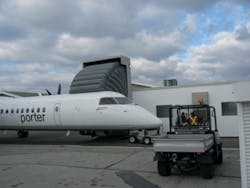A Light at the End of the Boarding Ramp
It seems rather ironic that, in this era of super-sized aircraft built to offer the long-distance traveler luxury largely unimagined until the recent past, some of the basic needs of the regional commuter are still largely neglected. While both widebody and narrowbody passengers are boarded and deplaned in relative comfort, transporting regional passengers from the terminal to the plane and back has always been and remains problematic. In spite of their large numbers, the procedures for handling the regional passenger remain somewhat unpredictable, because they don't easily fit into a passenger-handling infrastructure whose mainstays are apron-driven, second-story bridges.
Despite the fact that regional aircraft account for some 33 percent of the total airline fleet and some 15,000 regional flights per day in the US—as reported by the Regional Airline Association (RAA)—few would argue that the handling of regional travelers remains inferior in terms of customer service.
While it is undeniably important to the airline industry, a significant percentage of regional passengers continue to face wind-swept ramps, torrential rains and other extreme weather conditions while boarding or deplaning an aircraft. These negative factors are supplemented by the discomfort caused by the noise and air pollution encountered when crossing the ramp adjacent to active areas including idling aircraft, circulating GSE and the frenzied activities of cargo and baggage handling vehicles.
One can only assume that the relatively complacent regional passenger has either accepted the situation as "that's the way it is," found the trade-offs of hub connections to and from smaller airports or discovered other factors—such as greater flight frequency—to be worth the inconvenience. After years of being taken for granted, we can only hope that all regional aircraft passengers can look forward to enjoying more comfort and security in the years to come.
Equipment manufacturers have long provided viable solutions to this customer service dilemma. In examining the new equipment being purchased, there are indications that airports—Montreal's Pierre-Elliott-Trudeau and the Philadelphia Airport to mention two encouraging examples—as well as some, if not all airlines are turning their attention to improved regional boarding facilities.
If the newly emergent Porter Airlines, a regional passenger carrier based out of Toronto City Centre Airport is any indication, the trend is turning in favor of the commuter passenger. Porter, one of the newest members of the North American airline industry, presently serves three central Canadian routes and is poised to offer services to as many as 17 of the most-traveled, short-haul Canadian and US destinations. In addition to offering greater proximity to core downtown areas where possible, Porter prides itself on offering passengers a fully comfortable and secure environment in its access to and from the aircraft.
For example, Toronto has installed a custom-built, fully climate-controlled walkway between the terminal and aircraft. "This relatively small piece of infrastructure will make a noticeable difference for our passengers," says Robert Deluce, president and CEO of Porter Airlines. "Porter is enhancing the already convenient and comfortable passenger experience with this facilities investment."
It's a positive sign that airlines realize that the capital expenditure for protecting passengers is relatively small in regards to long-term benefits. Whether airlines, which now offer fully-covered stairs, walkways, customized ground-level or radial bridges, etc., will experience a sufficient competitive edge to fast-forward the momentum towards change, remains to be seen. If so, the provision of more widely-available, controlled passenger boarding environments may prove to make timely business sense on many levels.
In light of the time and money invested in assuring in-terminal security, allowing passengers to proceed from a sterile boarding area across an airport ramp, with virtually no effective containment or separation from the surrounding areas, may soon become unacceptable practice. The emphasis on security, in addition to concerns for customer comfort, may be just the impetus required to accelerate long-needed changes. Those members of the industry who have already adapted or who are presently poised to offer greater passenger comfort and security, may find themselves leading the long-awaited trend to improving the plight of the regional passenger.
